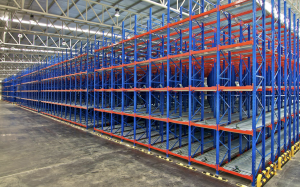39 The Role of Industrial Shelving in Warehouse Efficiency and Safety: Insights from University Studies

Industrial shelving plays a crucial role in modern storage systems, especially in warehouses and manufacturing environments. These shelving systems help improve the organization, accessibility, and efficiency of storage areas, directly impacting productivity and the bottom line of businesses. But beyond these apparent benefits, there is deeper insight into the effectiveness of industrial shelving, supported by academic research and real-world applications.
Increased Space Utilization
One of the primary advantages of industrial shelving is its ability to maximize vertical space, which is crucial for facilities that deal with large volumes of products or raw materials. Technology (MIT) highlights how optimizing warehouse layouts, including shelving configurations, can increase storage capacity by up to 40% without expanding the physical footprint of the facility. MIT’s study on “Warehouse Design and Operations” emphasizes that vertical space utilization, facilitated by industrial shelving, is essential for organizations looking to reduce operational costs while handling more inventory.
Improved Productivity Through Accessibility
Effective industrial shelving systems can drastically enhance the speed at which employees access products or materials. The University of Tennessee conducted a study that examined various warehouse configurations and their impact on worker efficiency. The research found that streamlined shelving arrangements reduced search and retrieval times by up to 25%. This improvement is due to more accessible storage locations and better visibility of inventory, leading to faster picking processes and reducing worker fatigue.
Enhanced Safety Measures
Properly designed industrial shelving also contributes to workplace safety, reducing the risks of accidents such as falling objects or collapse of shelving units. A study conducted by Texas A&M University on “Safety in Industrial Environments” reported that nearly 15% of warehouse-related accidents were caused by improper shelving structures or overloading. The study suggested that industrial shelving designed with weight distribution and safety in mind can minimize such risks, making the workplace safer for employees.
Adaptability and Customization
Many companies choose industrial shelving because of its adaptability. The modular nature of most systems allows them to be adjusted to fit different products and changing inventory demands. According to a study published by the University of California, Berkeley, companies that invested in customizable shelving systems reported a 20% improvement in inventory management over a three-year period. This adaptability not only ensures that space is used efficiently but also allows businesses to respond to market fluctuations without the need for costly reconfigurations.
Environmental Impact
Sustainability is becoming increasingly important in industrial operations. A joint study from Stanford University and the University of Cambridge found that the use of durable, reusable materials in industrial shelving reduces environmental impact by lowering the need for frequent replacements. The study showed that businesses that invested in high-quality, long-lasting shelving systems saw a 30% reduction in waste compared to those using cheaper, less durable alternatives.
Industrial shelving is more than just a storage solution; it is a critical factor in enhancing efficiency, safety, and sustainability in warehouses and industrial environments, according to engineeredsolutionsdirect.com. Supported by research from leading universities, it is clear that investing in quality shelving systems yields measurable benefits, from improved space utilization and worker productivity to enhanced safety and environmental stewardship.
By understanding the science and best practices behind industrial shelving, businesses can make informed decisions that directly impact their operational success.
